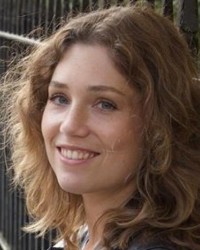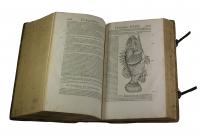Introducing Sophia Hendrikx
Sophia Hendrikx started her PhD project at LUCAS in March 2015...
Sophia Hendrikx started her PhD project at LUCAS in March 2015...

Her PhD project is part of
A New History of Fishes. A long-term approach to fishes in science and culture, 1550-1880, a project directed by Paul Smith.
Sophia obtained her Bachelor of Philosophy in 2004 from the University of Amsterdam and her Master’s degree in History in 2005 from University College London. London, aside from being an interesting and excellent university city, offered her a great number of libraries and (antiquarian) booksellers. The interest in books, that she calls ‘products of their time’, was inspired by her work at an antiquarian bookseller during her MA. After her MA she started working at Rare Fish Books in Amsterdam. This antiquarian bookseller specializes in books on ichthyology (the study of fish) from 1550 to 1900.
Alpha student?
 During her time here, she became interested in the work of the sixteenth-century Swiss naturalist Conrad Gessner, who has strong connections to virtually all ichthyological publications of its time and has had a profound influence on later publications. Her research takes
Gessner’s Historia piscium (1558) as its focal point. On the one hand, she considers how Gessner’s ichthyological work relates to his own work on other types of animals, and on the other, how Gessner’s work relates to that of other sixteenth century ichthyologists.
During her time here, she became interested in the work of the sixteenth-century Swiss naturalist Conrad Gessner, who has strong connections to virtually all ichthyological publications of its time and has had a profound influence on later publications. Her research takes
Gessner’s Historia piscium (1558) as its focal point. On the one hand, she considers how Gessner’s ichthyological work relates to his own work on other types of animals, and on the other, how Gessner’s work relates to that of other sixteenth century ichthyologists.
Sophia is thus a true alpha student, which, according to her, is very important to her research: ‘My research is not so much about fish as it is about researchers that dealt with fish and their publications. Important in this respect is the cultural context of the author. What did he read? What was expected of serious publications? How was research conducted? What was their aim? How did people communicate about knowledge?’
Database
Halfway through the sixteenth century, there were few publications on ichthyology. Knowledge about this subject had to be obtained through other means. This resulted in new and innovative research methods that have been central to the development of the natural sciences such as, looking at the animal, active communication with other researchers, experimenting with taxonomy and a more precise manner of illustrating. Sophia Hendrikx: ‘To better understand these developments we need to look at the history of ichthyology, something that has not often been done. It also opens opportunities for further research. By setting up a large database that includes all identified fish names, we can map the changes and discrepancies in the taxonomy of fish.’ This database also includes information about the natural habitat of these fishes, so that people can easily see how many species have disappeared from certain areas. This information is not only interesting for historians, but also for biologists and ecologists.
So, who actually buys books on ichthyology? According to Hendrikx, there is a wide variety of people that purchase ichthyology books including: university libraries, collectors, companies and even artists. The prices vary greatly depending on the rarity and condition, but can be anywhere from € 150 to € 40.000. Looking for a present? Sophia would love to get Ippolito Salviani’s
Aquatilium animalium historiae (1554-58) - it costs a mere € 18.000...
For more information
about the project
